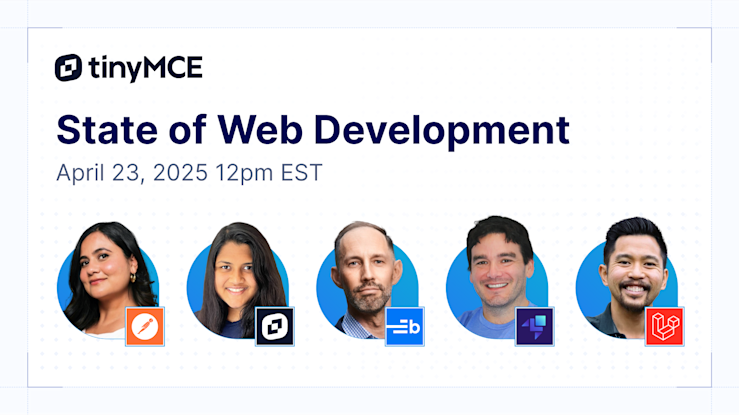Crafting content, whether for blogs, product descriptions, or collaborative tools, is central to digital communication. Open-source WYSIWYG (What You See Is What You Get) editors offer developers essential tools to create, customize, and manage content-rich applications. The challenge? Finding the right editor for your needs.
We’ll walk through ten of the best open-source WYSIWYG editors, spotlighting their strengths, features, and ideal use cases.
#1 TinyMCE: The go-to choice for versatility
TinyMCE is the trusted workhorse of WYSIWYG editors. Used by companies like Medium, Atlassian, and Evernote whose products depend heavily on text editing, it’s known for its unparalleled flexibility and seamless integration with modern frameworks.
Key features
- Extensive Customization: Configure toolbars, add plugins like PowerPaste, and integrate cutting-edge features like AI-assisted editing.
- Seamless Integration: Works with frameworks like React, Angular, and Vue, supporting both cloud-hosted and self-hosted setups.
- Accessibility First: Fully compliant with accessibility standards, ensuring inclusivity for all users.
TinyMCE pros & cons
|
Pros |
Cons |
|---|---|
|
Over 50 plugins for extended functionality, including collaboration tools and spell-checking. Most features require little code to implement. |
Advanced customization can be challenging without technical experience |
|
Scales easily for projects of all sizes |
Premium features come at additional costs |
|
Backed by a strong developer community |
🌟 Ideal for: Developers looking for a scalable, highly customizable editor for projects ranging from lightweight apps to enterprise-level solutions.
#2 CKEditor: Collaboration champion
CKEditor is an open source text editor specializing in real-time collaboration, making it perfect for team-based projects. It’s highly customizable and offers a modern, clean interface and powerful editing tools, though its advanced features can introduce complexity.
Key features
- Real-time Collaboration: Edit documents in real time with team members, complete with comment tracking and version history.
- Editing Modes: Choose from inline, balloon, or classic editing views to match your workflow.
- Robust Integration: Easily integrates with WordPress, Drupal, and popular SaaS platforms.
CKEditor pros & cons
|
Pros |
Cons |
|---|---|
|
Comprehensive set of tools for collaborative editing |
Requires significant setup time for advanced features |
|
Regular updates ensure top-notch performance and security |
Resource-heavy for smaller projects |
|
Highly customizable through a modular plugin system |
🌟 Ideal for: Teams working on collaborative platforms or applications requiring sophisticated editing and workflow management.
#3 TipTap: The modular innovator
TipTap offers a headless, framework-agnostic editor built for customization. While great for developers seeking full control, its lack of out-of-the-box features means additional development time.
Key features
- Framework Compatibility: Works seamlessly with Vue.js and React for modern SPAs (Single Page Applications).
- Extensive Customization: Build dynamic features from scratch using a flexible plugin system.
- Lightweight Core: Focuses on speed and performance, leaving the UI design entirely in your hands.
TipTap pros & cons
|
Pros |
Cons |
|---|---|
|
High flexibility for tailored solutions |
Requires significant effort to implement standard features |
|
Active community and detailed documentation |
Resource-heavy for smaller projects |
|
Minimalist architecture ensures fast load times |
Relies on community plugins, which may vary in quality |
🌟 Ideal for: Experienced developers building custom web applications with precise editing requirements.
#4 QuillJS: Simplicity at its core
QuillJS is a lightweight and beginner-friendly editor built for basic text editing needs. Its modular architecture and free, open-source nature make it accessible, though it lacks the depth of more feature-rich alternatives.
Key features
- Easy Integration: Embeds quickly into projects without the need for extensive setup.
- Customizable Themes: Offers basic styling options to align with your project’s design.
- Minimalist Design: Focuses on essential text editing without unnecessary complexity.
QuillJS pros & cons
|
Pros |
Cons |
|---|---|
|
Free and open-source, making it budget-friendly |
Limited plugin ecosystem compared to more advanced editors |
|
Simple, clean interface that’s easy for end-users to navigate |
Lacks robust collaboration or advanced editing features |
|
Small footprint ensures fast loading times |
🌟 Ideal for: Small-scale projects or developers seeking a no-frills text editor with quick deployment.
#5 Draft.js: Purpose built for React
Created by Facebook, Draft.js is a JavaScript framework tailored for building highly customizable rich text editors. While it shines in React ecosystems, its complexity and minimal out-of-the-box features can be a hurdle.
Key features
- Customizable Content Blocks: Allows precise control over formatting and content structure.
- React Integration: Built to leverage React’s component-based architecture.
- Advanced Editing Tools: Offers support for inline styles, decorators, and plugins.
Draft.js pros & cons
|
Pros |
Cons |
|---|---|
|
Simple integration with React applications |
Steep learning curve for beginners |
|
Flexible architecture for advanced, custom editing solutions |
Lacks active development compared to competitors |
|
Backed by Facebook, ensuring credibility and community support. |
Minimal out-of-the-box functionality requires significant setup |
🌟 Ideal for: React developers building tailored rich text editors for complex applications.
#6 Editor.js: Structured content pioneer
Editor.js takes a unique approach to text editing with its block-based architecture, focusing on producing structured JSON output. It’s perfect for developers working with APIs or dynamic content but may be too niche for traditional content creation.
Key features
- Block-Based Editing: Treats each piece of content as a distinct, editable block.
- JSON Output: Generates clean, structured data for API-driven workflows.
- Custom Block Support: Developers can create tailored blocks for specialized content types.
Editor.js pros & cons
|
Pros |
Cons |
|---|---|
|
Lightweight and fast |
May require additional tools to handle non-developers’ workflows |
|
Extensible with custom block development |
Limited use cases outside of structured content applications |
|
Ideal for structured data and API integration |
🌟 Ideal for: Developers creating headless CMS platforms or dynamic, API-driven applications.
#7 Lexical: Modern and scalable
Lexical, developed by Meta, is a modern text editor framework optimized for scalability and performance. Its focus on extensibility and a modular approach make it a strong contender for large projects.
Key features
- High Performance: Designed to handle high-volume, real-time editing.
- React-First: Optimized for React projects but can adapt to other frameworks.
- Rich Plugin Ecosystem: Supports advanced features like real-time collaboration and voice adjustments.
Lexical pros & cons
|
Pros |
Cons |
|---|---|
|
Modern architecture with a focus on speed and scalability |
Relatively new with limited community support |
|
Strong foundation for custom plugins and extensions |
Heavily tied to React, limiting cross-framework versatility |
|
Backed by Meta for reliability |
🌟 Ideal for: Teams building complex, React-based applications requiring high-performance text editing.
#8 Trix: Minimalism meets elegance
Trix is all about simplicity and elegance. Built with Rails in mind, it’s perfect for projects where basic editing features are enough, but it lacks the extensibility of other editors.
Key features
- Rails Integration: Tailored for Ruby on Rails applications.
- Minimalist Design: Aims for distraction-free editing with basic formatting tools.
- Lightweight Build: Quick to load and easy to use.
Trix pros & cons
|
Pros |
Cons |
|---|---|
|
Clean, intuitive interface ideal for simple editing tasks |
May require additional tools to handle non-developers’ workflows |
|
Fast and efficient, even on resource-limited systems |
Limited use cases outside of structured content applications |
|
Great for Rails developers |
🌟 Ideal for: Rails projects requiring a lightweight, no-frills editor.
#9 ProseMirror: The tinkerer's dream
ProseMirror is a toolkit for developers who want complete control over their text editing experience. Its schema-driven architecture enables unparalleled customization but demands significant effort.
Key Features
- Customizable Schemas: Tailor the editor to specific content needs with complete control over structure.
- Framework-Agnostic: Works with any stack, giving developers flexibility.
- Collaborative Editing: Supports real-time collaboration for team environments.
ProseMirror pros & cons
|
Pros |
Cons |
|---|---|
|
Unmatched flexibility for creating unique editing solutions |
Steep learning curve and resource-intensive implementation |
|
Ideal for complex workflows and custom requirements |
Requires advanced development expertise |
|
Active community for support and plugins |
🌟 Ideal for: Developers with highly specific editing needs and the resources to build a custom solution.
#10 Summernote: A simple solution
Summernote is a straightforward, lightweight editor designed for basic rich text editing. Its reliance on jQuery makes it ideal for legacy projects, but less appealing for modern frameworks.
Key features
- Quick Integration: Easy setup with minimal configuration.
- Customizable Toolbar: Adjust layout and tools to suit your needs.
- Basic Plugin Support: Extend functionality with simple plugins.
Summernote pros & cons
|
Pros |
Cons |
|---|---|
|
Free and easy to use |
Limited features compared to modern editors |
|
Works well in legacy environments |
Relies on jQuery, which is less common in contemporary development |
|
Great for small, straightforward projects |
🌟 Ideal for: Legacy systems or developers seeking a quick, lightweight editor.
Final thoughts: Which open source text editor is right for you?
Choosing the right WYSIWYG editor depends on your project’s needs. For enterprise-scale solutions, TinyMCE or CKEditor are your strongest contenders. If you want an RTE that's framework agnostic, ProseMirror and TipTap are great choices. If you’re a React developer, Draft.js or Lexical offers tailored integration. Need something lightweight? QuillJS, Trix, or Summernote could be perfect.
Comparison table of open source WYSIWYG HTML editors
Here’s a comparison table summarizing the key attributes of the WYSIWYG editors discussed. The table highlights core features, ideal use cases, and complexity levels to help developers quickly identify the best fit for their projects.
|
Editor |
Key Features |
Ideal For |
Complexity Level |
|---|---|---|---|
|
TinyMCE |
Advanced customization, accessibility support, plugin ecosystem |
Scalable apps, enterprise-level solutions |
Low to high |
|
CKEditor |
Real-time collaboration, modular plugins, multiple editing modes |
Team-based platforms, collaborative workflows |
Moderate to high |
|
TipTap |
Framework-agnostic, modular design, high flexibility |
Custom SPAs, heavily tailored applications |
High |
|
QuillJS |
Simple and lightweight, basic customization |
Beginners, small projects needing minimal functionality |
Low |
|
Draft.js |
React integration, custom content blocks, modular architecture |
React-based custom editors, high-control applications |
High |
|
Editor.js |
Block-based editing, JSON output, API-friendly |
Structured content, headless CMS platforms |
Moderate |
|
Lexical |
High scalability, rich plugin support, modern architecture |
React-based, large-scale applications |
Moderate to high |
|
Trix |
Rails integration, minimalist design, lightweight performance |
Ruby on Rails projects needing basic editing |
Low |
|
ProseMirror |
Custom schemas, collaborative tools, framework-agnostic |
Highly specific, complex custom solutions |
Very high |
|
Summernote |
Quick setup, jQuery support, basic features |
Legacy systems, lightweight rich text needs |
Low |




